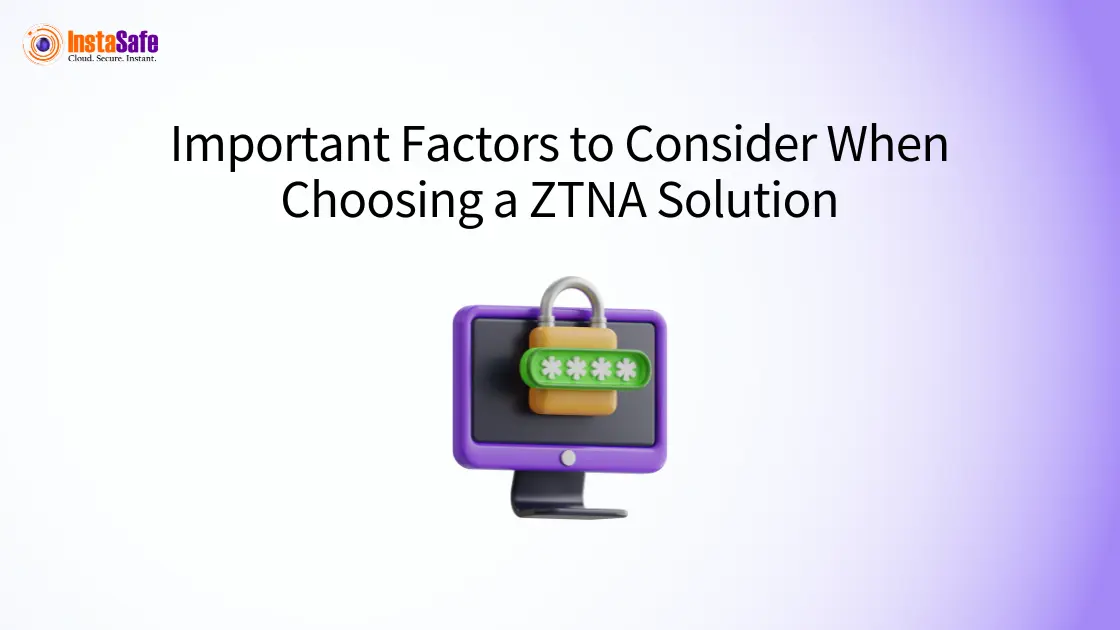Important Factors to Consider When Choosing a ZTNA Solution

As the world is getting more complicated, businesses are facing cyber threats like never before. Border-based security methods fail to function anymore as workers are spread out and applications move to the cloud.
As a result of this change, several companies have started favouring the robust zero-trust network access architecture, which is based on the idea that "never trust, always verify." When implementing this approach, selecting the right ZTNA solution is critical for success.
This blog explores the essential factors organisations should evaluate when choosing among the many ZTNA options available in the market to ensure security, performance and value.
Understanding Zero Trust Network Access (ZTNA)
Zero trust network access (ZTNA) represents a powerful alternative to traditional VPN-based approaches to secure access. Instead of granting broad network access, ZTNA creates secure, individual connections between users and specific applications or resources they need.
This application-level approach significantly reduces the attack surface by eliminating unnecessary network exposure. The core principles of ZTNA include continuous verification of user identity, device health validation and least-privilege access controls. The popular ZTNA use cases include secure remote workforce access, third-party access management and cloud migration security.
By implementing a strong ZTNA solution, organisations can better protect sensitive data while improving user experience through seamless access methods. As the market for the best ZTNA solutions continues to evolve, understanding the fundamental components and benefits is essential before evaluating specific vendor offerings.
Factors to Consider When Choosing a ZTNA Solution
Security and Access Controls
The primary purpose of any ZTNA solution is to enhance security, making this the most critical evaluation factor. Look for solutions that provide granular access controls, allowing administrators to define precise permissions based on user identity, role, location, device status and other contextual factors. Strong ZTNA implementations should support both agent and agentless deployment options to accommodate different access scenarios.
Multi-factor authentication (MFA) integration is essential, as is continuous monitoring of sessions for suspicious activities. The most effective zero-trust network access platforms provide detailed activity logging and real-time alerting to help security teams identify potential threats. Consider solutions that offer data loss prevention capabilities and integration with existing security tools.
Popular ZTNA use cases like protecting internal applications require strong encryption for all connections. Evaluate how vendors handle encryption both in transit and for stored credentials. To guarantee that only authorised devices can connect to company resources, the best ZTNA solutions will also enable modern authentication protocols and certificate-based validation.
Scalability and Performance
As organisations grow, their ZTNA infrastructure must scale accordingly. Evaluate how potential solutions handle increasing numbers of users, applications and connection requests. Cloud-based ZTNA solution offerings often provide better scalability than on-premises alternatives but verify the vendor's global presence of supporting international users.
Performance is equally important—users will resist security measures that significantly slow their work. The best ZTNA solutions minimise latency by optimising traffic routing and maintaining distributed access points.
Test solutions under realistic load conditions to ensure they meet performance requirements. Consider deployment flexibility as well. Some zero trust network access platforms work exclusively in cloud environments, while others support hybrid deployments.
Assess whether the solution can accommodate all your ZTNA use cases, including cloud applications, on-premises resources and legacy systems. Finally, evaluate the management overhead required to maintain the solution as your environment grows and changes.
Integration with Existing Infrastructure
When selecting a ZTNA solution, compatibility with your current IT ecosystem is crucial. The best implementations connect seamlessly with existing identity providers, directory services and security tools. Evaluate how potential ZTNA platforms integrate with your authentication systems like Active Directory or Azure AD.
Consider how the solution works with your current security stack, including SIEM systems, endpoint protection platforms and cloud access security brokers. Strong API capabilities are essential for automation and custom integrations.
Many organisations have specific ZTNA use cases that require specialised integrations with legacy applications or unique infrastructure components. The best ZTNA solutions offer flexible deployment options that work with both cloud and on-premises resources.
Check whether the solution supports all your required protocols and can protect various application types, including web apps, SSH connections and RDP sessions. Zero trust network access implementations should enhance your security posture without requiring complete infrastructure overhauls. Look for vendors with strong professional services teams who can help navigate complex integration challenges during implementation.
User Experience and Ease of Deployment
Even the most secure ZTNA solution will fail if users find it difficult or frustrating to use. The best systems operate transparently, with minimal disruption to existing workflows. Evaluate the user experience across different devices and access scenarios. Mobile compatibility is especially important for organisations with remote or travelling staff.
Client software should be lightweight, unobtrusive and easy to install. Many zero trust network access platforms now offer clientless options for certain applications, which can simplify deployment and improve adoption. The administrative experience matters too—look for intuitive management consoles and straightforward policy configuration tools.
Deployment complexity varies widely among ZTNA solution providers. Consider the resources required for initial setup, ongoing maintenance and updates. Some vendors offer phased implementation approaches that allow for gradual rollout across different user groups or applications.
This can be particularly valuable for complex ZTNA use cases involving sensitive systems. The best ZTNA solutions include comprehensive documentation, training resources and responsive support teams to assist with deployment challenges.
Compliance and Regulatory Requirements
Organisations in regulated industries must ensure their ZTNA implementation meets specific compliance standards. Evaluate whether potential solutions offer features that support requirements like GDPR, HIPAA, PCI DSS or industry-specific regulations. Look for capabilities such as data residency controls, comprehensive audit logging and separation of duties.
The best ZTNA solutions provide detailed visibility into user activities, making compliance reporting more straightforward. Consider whether the solution offers built-in compliance templates or reporting tools. Some vendors maintain their own compliance certifications, which can simplify your audit processes.
Zero trust network access architectures inherently support many compliance objectives through their granular access controls and reduced attack surface. Common ZTNA use cases in regulated environments include protecting sensitive data access, ensuring third-party compliance and maintaining audit trails for privileged user activities.
When evaluating a ZTNA solution, verify that the vendor understands your specific regulatory landscape and can demonstrate how their product addresses your compliance needs.
Cost and Total Cost of Ownership (TCO)
While upfront pricing is important, evaluating the total cost of ownership of a ZTNA solution over time provides a more accurate financial picture. Consider licensing models—some vendors charge per user, others per application or connection. Understand how costs will scale as your organisation grows or as you expand your ZTNA use cases.
Implementation costs often extend beyond software licenses to include professional services, training and potential infrastructure upgrades. Ongoing operational expenses should factor in administrative overhead, support costs and regular maintenance requirements. The best ZTNA solutions offer clear, predictable pricing models without hidden fees.
Consider potential cost savings as well. Effective zero-trust network access implementations can reduce expenses related to traditional VPN infrastructure, decrease the risk of costly data breaches and improve IT operational efficiency.
Many organisations find that cloud-based ZTNA solutions offer better cost optimisation than on-premises alternatives by eliminating hardware refresh cycles and reducing data centre costs. When calculating ROI, include both hard savings and softer benefits like improved security posture and enhanced user productivity.
Conclusion
Selecting the right ZTNA solution requires careful evaluation across multiple dimensions. By thoroughly assessing security capabilities, performance, integration options, user experience, compliance features and total cost, organisations can identify the best ZTNA solutions for their specific needs.
InstaSafe's industry-leading ZTNA solution provides enterprise-grade security without sacrificing performance. Our platform offers granular access controls, continuous authentication and seamless integration with existing infrastructure. So, consider all these factors and protect your distributed workforce and cloud applications through Instasafe powerful zero-trust architecture.
Frequently Asked Questions (FAQs)
What are the key features of our network access within the ZTNA solution?
A robust ZTNA solution provides micro-segmentation, least privilege access, continuous verification and application-level controls. It implements identity-based security with encrypted connections and real-time monitoring to prevent unauthorised access across all protected resources.
What are the 5 C's in security?
The 5 C's aligning with zero trust network access are Confidentiality (protecting sensitive data), Compliance (meeting regulations), Control (implementing access restrictions), Consistency (maintaining uniform policies) and Coverage (ensuring protection across all ZTNA use cases).
What are the requirements for a zero-trust network?
Implementing ZTNA requires strong identity verification, continuous authentication, micro-segmentation, least privilege policies and traffic encryption. Additional requirements include constant monitoring, contextual policy enforcement, device security assessment and comprehensive visibility across environments.
What are the two approaches to implementing ZTNA?
The best ZTNA solutions offer agent-based approaches with software installed on endpoints for deep integration and device checks or agentless browser-based access that requires no endpoint software. This makes it ideal for BYOD scenarios and zero-trust network access implementations.
